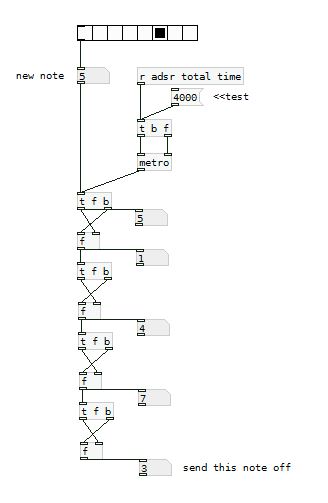Keeping track of note-ons and note-offs for a polyphonic synth can be a pain. Luckily, the [poly] object can be used to take care of that for you. However, the nuts and bolts of how to use it may not be immediately obvious, particularly given its sparse help patch. Hopefully this tutorial will clarify its usefulness. It will probably be easier to follow along with this explanation if you open the attached patch. I'll try to be thorough, which hopefully won't actually make it more confusing!
To start, [poly] accepts a MIDI-style message of note number and velocity in its left and right inlets, respectively...
[notein]
| \
[poly 4]
...or as a list in it left inlet.
[60 100(
|
[poly 4]
The first argument is the maximum number of voices (or note-ons) that [poly] will keep track of. When [poly] receives a new note-on, it will assign it a voice number and output the voice number, note number, and velocity out its outlets. When [poly] gets a note-off, it will automatically match it with its corresponding note-on and pass it out with the same voice number.
By [pack]ing the outputs, you can use [route] to send the note number and velocity to the specified voice. For those of you not familiar, [route] will take a list, match the first element of the list to one of its arguments, and send the rest of the list through the outlet that goes with that argument. So, if you have [route 1 2 3], and you send it a list where the first element is 2, then it will pass the rest of the list to the second outlet because 2 is the second argument here. It's basically a way of assigning "tags" to messages and making sure they go where they are assigned. If there is no match, it sends the whole list out the last outlet (which we won't be using here).
[poly 4]
| \ \
[pack f f f] <-- create list of voice number, note, and velocity
|
[route 1 2 3 4] <-- send note and velocity to the outlet corresponding to voice number
At each outlet of [route] (except the last) there should be a voice subpatch or abstraction that can be triggered on and off using note-on and note-off messages, respectively. In most cases, you'll want each voice to be exact copies of each other. (See the attached for this. It's not very ASCII art friendly.)
The last thing I'll mention is the second argument to [poly]. This argument is to activate voice-stealing: 1 turns voice-stealing on, 0 or no argument turns it off. This determines how [poly] behaves when the maximum number of voices has been exceeded. With voice-stealing activated, once [poly] goes over its voice limit, it will first send a note-off for the oldest voice it has stored, thus freeing up a voice, then it will pass the new note-on. If it is off, new note-ons are simply ignored and don't get passed through.
And that's it. It's really just a few objects, and it's all you need to get polyphony going.
[notein]
| \
| \
[poly 4 1]
| \ \
[pack f f f]
|
[route 1 2 3 4]
| | | |
( voices )






